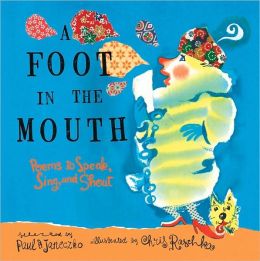
BIBLIOGRAPHY
Janeczko, Paul. 2009. A FOOT IN THE MOUTH: POEMS TO SPEAK, SING, AND
SHOUT. Ill by Chris Raschka. Cambridge, MA: Candlewick Press. IBSN: 978-0-7636-0663-3.
REVIEW AND
CRITICAL ANALYSIS
A FOOT IN THE MOUTH is a poem anthology compiled by Paul B. Janeczko
and illustrated by Chris Raschka. It is the follow-up book to the series
containing A POKE IN THE I (2001) and A KICK IN THE HEAD (2005), also
written by Janeczko. All 37 poems in this anthology are designed to be read out loud. Janeczko’s explains in his introduction,
“Poetry is sound. Oh, sure it’s other things, too, but sound needs to be near
the top of the list. To hear the sound of a poem, really hear it, you need to
read it aloud. Or have someone read it to you.”
A FOOT IN THE MOUTH includes many different types of poetry written by familiar poets or authors as well as others that are less well known. Old classic poets like Lewis Carroll and Edward Lear, as well as more modern poets like Georgia Heard and Douglas Florian are all featured in this book. The poems are organized by poems for one voice, tongue twisters, two voices, list poems, three voices, short poems, bilingual poems, rhymed poems, limericks, and poems for a group. A table of contents is included to help the reader easily navigate the book.
A FOOT IN THE MOUTH contains poems about everything from ping pong to the Nicaraguan Revolution. The language and tone of the poems included in the book is as varied as the subject matter. Everything from humorous poems like "Pasta Parade" to much more serious poems like "My Memories of the Nicaraguan Revolution" are included. The poems all include strong sound elements like rhyme, alliteration, repetition and onomatopoeia. These elements help to ensure each poem is a treat for the readers ears.
While the poems are pleasing to the ears, the illustrations are pleasing to the eyes. Chris Raschka uses ink and water colors on torn paper to create vivid and bright illustrations. The unconventional illustrations add to and sometimes further explain the poems. Although the illustrations are bright and bold, Raschka has left enough white space on the page so they don't distract from the poetry itself.
"Squirrel and Acorn"
Where's that nut
I hid in the fall?
Bad news!
Bad news!
Can't recall.
Must think,
Try hard,
Somewhere
In the yard.
Look here,
Look there,
Bad news!
Nowhere!
I'm here
Below,
Just under the
Snow,
Off to his
Right--
Well out of
Sight.
He can't
Recall?
Then I'll
Grow tall.
Could be a
Tree.
Good news!
Good news!
Good news
for me!
This poem is written for two voices, a squirrel and an acorn. The illustrations show a squirrel with his hands on his head, looking confused and an acorn buried below the snow possibly sprouting roots to begin to grow tall.
This book lends itself well to inferencing lessons as well as adding expression to our reading. Because the poems are meant to be read aloud, they are written with a lot of voice. To be able to read the poems with expression a reader has to infer what the tone of the poem is. For example, in "Squirrel and Acorn" the reader can use the clues in the poem to infer the squirrel is sort of frantically trying to find the acorn and is disappointed when he can't find it. When this is read aloud, the expression the reader uses should match his mood. The acorn, on the other hand, seems to be cautiously optimistic at first that he won't be found and his excitement grows when he realizes that the squirrel has forgotten where he hid the acorn and he can grow into a tree. Students could perform their interpretations of the poems, paying close attention to their expression.

No comments:
Post a Comment